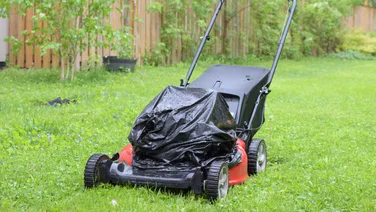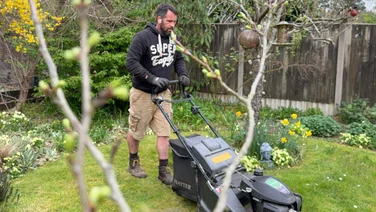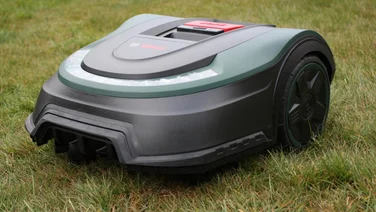To help us provide you with free impartial advice, we may earn a commission if you buy through links on our site. Learn more











- Handles complex garden shapes
- Simple scheduling with app
- Can form part of a larger automated garden
- Additional wire is more pegging and splicing
- No obstacle detection
- Random mowing
The vast majority of robot lawn mowers cut grass in a random pattern, which can make it tough for them to reach some areas of your garden. The Gardena Sileno City isn’t much different in this respect, but it has one innovation that might help.
As well as the usual perimeter wire, which stops the mower from wreaking havoc in your vegetable patch, it comes with an additional guide wire, which is used to divide your lawn into sections so the mower can navigate to areas that might otherwise be difficult to get to.
Couple this with a handy smartphone app, which controls scheduling and adds some extra intelligent features, and the Sileno City could be everything you need to keep your lawn trimmed with minimum effort.
Gardena Sileno City review: What do you get for the money?
There are various configurations of this robot lawn mower. The one you opt for will depend on the size of your garden and whether you want to control it from your smartphone using Bluetooth or connect the mower up to your Wi-Fi, which requires an additional gateway device.
Our test unit came with the gateway, which connects to your router via Wi-Fi or Ethernet, and gives you the scope to expand your garden automation into watering and beyond by buying more equipment that can connect to it. It’s a significant extra investment, however, and adds about £200 to the cost of the mower.
The robot itself measures 380 x 550 x 230mm (WDH), weighs 7.3kg and will cut lawns with an area of up to 300m² with a maximum incline of 35%. Its sleek blue and grey colouring isn’t as garish as the orange and black we see on many other robot mower brands, but it’s still not going to blend into your lawn.
It has a cutting system that’s 16cm wide and can be adjusted to cut your grass lengths between 20mm and 50mm. This is controlled using a dial on the top of the mower, where you’ll also find control buttons and a simple monochrome screen.











You can use buttons to start and stop the mower directly or set up a schedule, and it’s protected with a four-digit PIN to stop people meddling with your settings. Generally, though, I found it simpler to control the mower using the companion app.
In the box you also get the charging station, a 150m reel of perimeter wire to prevent your robot venturing into the flower beds, and enough pegs to secure it all to the ground.
READ NEXT: Best weed killer
Gardena Sileno City review: Is it difficult to set up?
Once you’ve chosen a location for the charging station, which needs to be within reach of an external power socket, you can start laying wire.
All robot lawn mowers have to be corralled using a perimeter wire, which takes a bit of setting up. One end is connected to the back of the charging station, then unrolled from a reel around the edge of the area you want to mow and pegged down. Once you get to the other end of the loop, you can cut the wire and connect it to another port on the back of the station. Clips are provided for this, so you don’t even need to strip the wire.
The Gardena comes with the added complication that most robot lawn mowers don’t bother with: a guide wire. This also connects to the back of the charging station, runs underneath the robot’s home and is reeled out on the other side.











It’s designed to ensure the mower can get to difficult-to-reach areas of your lawn (perhaps an area that’s connected by a narrow corridor of grass), and it also helps the robot find its way home again when it’s finished the job.
The main hassle with this is that, at the other end of the guide wire, you have to break your perimeter wire and splice the guide wire into the circuit. Connector clips are supplied to perform this without needing anything more than a pair of pliers, but it’s a task that’s likely to sit outside many people’s comfort zone.
Once everything is set up, however, I found connecting to the mower through the app and starting it mowing was relatively straightforward.
READ NEXT: Best lawn feed
Gardena Sileno City review: How well does it mow the lawn?
Where some robot lawn mowers locate their charging stations in line with the perimeter wire so the mower can follow the wire back home, the Gardena follows its additional guide wire back home, so the charging station sits at a right angle to the perimeter. This allows the Sileno City to mow around the front of its station and keep that area neat and tidy. You’d be surprised how many robot mowers let a meadow grow around their chargers.
Because the cutting system is in the middle of the mower chassis, it doesn’t get right up to the edge of your lawn, particularly if your lawn has edges that are raised or lowered. It also won’t cut all the way into a right-angled corner, because the perimeter wire has to be curved around sharp corners. The manual suggests keeping a 30cm distance between the perimeter and any raised edges, which will leave a strip of about 10cm uncut around the edge of your lawn.











The extra guide wire genuinely helps the mower find its way around difficult-shaped gardens, though. If you have a garden with two areas, connected by a narrow strip of grass, for example, there’s only a slim chance that the mower would hit the gap in the normal course of mowing and, even if it did find its way there, it might well get stuck at the other end.
With the guide wire in place you can set the mower to start at the far end and divide the available mowing time between three areas. There’s also a corridor setting, which reduces the amount of time the mower bounces around narrow spaces.
This is all easily controlled using the app. You can use the app to set a schedule, which lets you choose which days and times you’d like it to mow and for how long. However, if you’d prefer even more automation, you can also use the app’s optimisation tools, which do clever things such as detect how thick the grass is as it mows to establish whether it needs to keep mowing beyond its usual scheduled time limit.
It’s worth noting that, unlike robot vacuum cleaners, this robot mower doesn’t have any collision detection. It happily bounces off solid obstacles and you can protect precious fixtures with the perimeter wire, but it isn’t going to deal with a garden full of discarded children’s toys or sleeping pets. If this is a problem, consider the YardForce Compact 400Ri instead, as this has collision detection built in.
READ NEXT: Best garden hose
Gardena Sileno City review: Should I buy it?
Because of its extra guide wire, the Gardena Sileno City is perfectly equipped for unusually shaped gardens. It makes setup a little more complicated and time-consuming, but you only have to go through this once, and there’s a certain amount of setting up that needs to be done with any robot lawn mower.
However, the extra guide wire is only of benefit to those with complicated gardens. If your lawn is less challenging, you could easily get away with a cheaper model such as the LawnMaster L10 or the YardForce Compact 400Ri.







